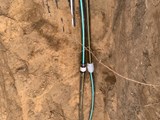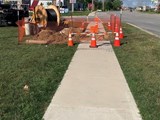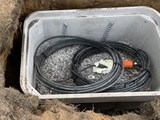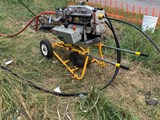300 MILE LONG HAUL FIBER PROJECT
Due to expanded 5G cellular service and the Internet of Things (IOT), the demand for bandwidth continues to increase. As a result, more fiber is going in the ground to carry these data streams. °On a bitterly cold December day six Electric Conduit Construction (ECC) crews worked to add a 432-count fiber optic cable to an existing system. As their shovels unearthed a handhole, they thought about those pleasant months of October and November. They still had two hundred miles ahead of them.
The work requires that crews haul and manipulating 24,000’ reels of fiber locating the access points along the right-of-way and setting up traffic control. Crews prepare each segment by exposing handholes, identifying the conduit run, coupling conduits together and, using a Track machine and 400 cfm compressor, blow the fiber 5,000’ to 10,000’. Crews continue this process for each segment of the right of way (ROW) until they empty a 24,000’ spool. Then they start over again. When a Track machine is not immediately available crews must lay the fiber in a figure of eight to stack up the slack. The crew then flips the bundle over, and a laborer feeds the fiber into the Track machine to blow another 5,000’ or 10,000’ segment. By doing these steps repeatedly crews install hundreds of miles of fiber is in increments of 5,000 to 10,000’ per day.
When a crew completes a set of tasks repeatedly, complacency can set in. Complacency leads to accidents and injuries. Construction is challenging because using force to manipulate material can cause problems if workers do not follow safety procedures. Foul weather can increase hazards. On this project, when the weather was good there were still hazards in the form of slips and trips and line of fire potential injury. Now as the season turns into winter the crews have ice, snow, and wind chill to deal with. Working close to icy highways adds the potential for vehicles to skid into the work zone. ECC Safety Officers use due diligence, safety audits and toolbox talks, to keep the crews focused on their safe work practices. Foremen and crews must plan every task. To stay safe, they must work as a team, watch each other and the surrounding environment.
Fiber is flexible but at temperatures below 25°F the risk of damaging the individual fiber strands increases with handling, especially when laborers stack slack into a figure of eight. When temperatures reach this point superintendents will suspend work until the weather warms.
ECC and other contractors will install thousands of miles of fiber every year. Fiber is more secure than wireless and offers more bandwidth and speed. Electric Conduit Construction Company prides itself on how their Project Managers, plan and control each project. Our customers appreciate our in house permitting, as well as the way manpower and equipment are allocated. Monitoring the budget and rate of expenditure is another way that ECC controls the cost of the project and helps save our customers money.
ECC is a 60-year-old underground and overhead utility contractor. Areas of expertise include fiber optic cable installation, testing, termination; overhead and underground distribution electrical; Horizontal Direction drilling (HDD), Industrial power and control wiring for plants, EV Chargers and other facilities; Small cell radio, antenna, and fiber network interface installation; and complete restoration services. To submit an RFI or bid request click on Request a Project.

















